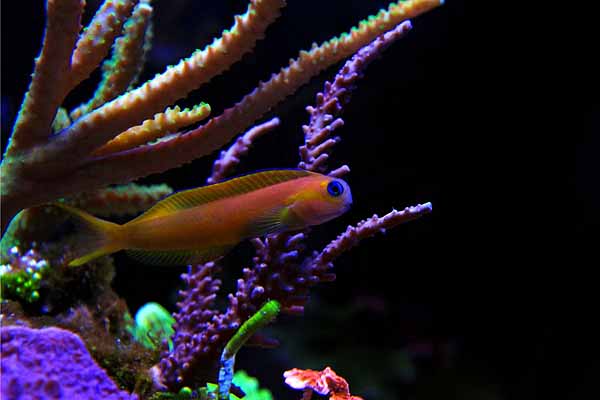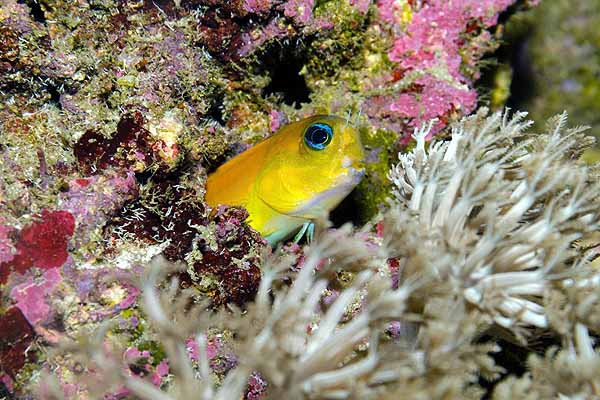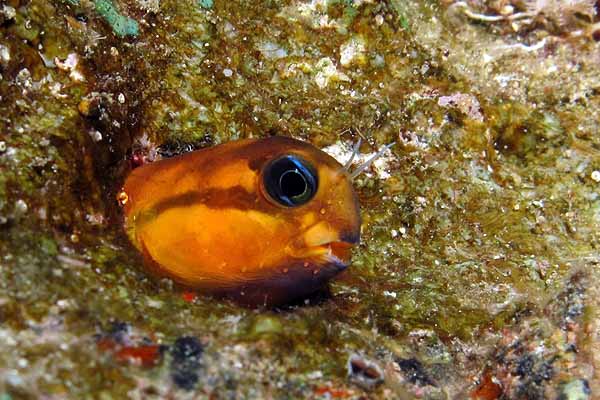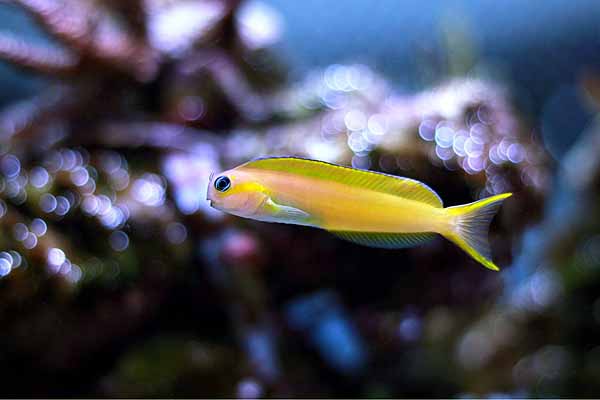[ad_1]
The Midas blenny, Ecsenius midas, is great beginner fish for a medium-sized aquarium or larger (about 20-30 gallons, or larger) who are looking to add a little Golden touch to their tanks. Let’s dive in to see what it takes to properly care for this gorgeous, golden fish in a saltwater aquarium
Table of contents
Please use the following navigational links to go to the section that interests you, or keep going, to read the full article.
Quick Facts
- Scientific Name: Ecsenius midas
- Common Names: Midas blenny, Gold blenny, Lyretail blenny
- Max Size: ~4-6 inches
- Minimum tank Size: 20-30 Gallons (Larger is okay)
- Aggression Level: Low (they are generally peaceful creatures)
- Care Level: Suitable for beginners
- Most Active: Day
- Price: Moderately high (especially for beginners). If the price is an issue, consider a Canary blenny, instead
- Feeding/Diet: Omnivore/planktivores, will likely learn quickly to eat a variety of aquarium foods
Care guide
Like many fish in the aquarium trade, the Midas blenny comes from Indo-Pacific reefs. Individual specimens will reflect a coloration pattern slightly distinct for the region they come from (or where the original parental broodstock came from. They are generally peaceful, with some reports of aggression–which we will describe in more detail below.
Variation in color across different individuals
It’s likely no surprise to you where Ecsenius midas, a.k.a. the Midas blenny gets its name. Just take a look. They have a deep golden color, with strikingly beautiful and vibrant blue accents around the eyes and fins. The colors of the individual Midas blenny you get will vary a bit, depending on what part of the world it comes from.
Fishes from the Indian Ocean and the Red Sea are reported to have more vibrant colors than their fishy cousins from the Pacific.
Did you know that Midas blennies also change colors when they are stressed? As such, they can sort of be considered canaries in your reef aquarium coal mine–a color change may be your first sign of trouble.
Diet and Feeding
The Midas blenny is an omnivore, which means it needs both meaty and plant-based foods in its diet to remain healthy, which is different from many of the other blennies, which often eat predominantly plant-based foods. It is recommended, therefore to include prepared foods with algae ingredients–spirulina, Formula Two, etc.
They are generally active feeders, that will gladly snap up foods floating in the currents.
Feed your Midas blenny a few times a day (if you are home) with brine shrimp, mysid shrimp, chopped up clams or mussels, and algae-based foods containing spirulina or other herbivorous foods.
Are they aggressive?
One of the most common questions I hear, about the Midas blenny, is whether they are aggressive. The answer appears to be…it depends. In general, the Midas blenny is NOT aggressive. It is a peaceful community saltwater fish that does tend to be compatible with most of the other tropical reef saltwater fish. However, there are a few exceptions.
There are reports of aggression between this species and either other blennies or some of the more mild-mannered fish that are potentially competing for similar planktonic foods, like Firefish or small gobies. But otherwise, they are generally a peaceful community aquarium fish.
Most of the discussion around aggression in Midas blennies also tends to include the size of the aquarium as a potential factor, perhaps not surprisingly. Since this is an otherwise peaceful fish, the tendency to be aggressive towards some may be linked to defending their territory and/or perceived food-source. If that is the case and the root cause of the aggression, the confines of a smaller reef tank are likely to be a confounding or inflammatory factor.
It is therefore advisable to have extra care and restraint in keeping the Midas blenny with other blennies or gobies if your tank is on the smaller end of the scale.
Reef safe, or not?
The Midas blenny is also generally considered to be reef safe, getting along with most other saltwater aquarium fish (considering the exception noted above) and not likely to cause trouble with reef invertebrates.

Note the gold color of the Midas blenny in a reef tank
Aquarium conditions
The Gold blenny, Ecsenius midas, does well with the traditional reef aquarium water parameters.
- Temperature: 73-84 Fahrenheit (~22.8-28.8 Celcius)
- pH: 8.1- 8.4
- Salinity: ~1.025
- Ammonia: 0 ppm
- Nitrates: 0 ppm
- Nitrites: 0 ppm

This Midas blenny’s burrow is right next to xenia coral
Breeding
Midas blennies are not (at least at the time of publication) listed as a fish that has been Captive-bred, but other species within the genus have–which gives me hope that we are not that far away from having commercially raised, Captive-bred Ecsenius midas available and will no longer depend on wild-caught individuals.
At the same time, the fact that several other members of this genus have been bred, suggests there is something about the rearing of the larvae that evades us, at least so far.
As such, I will share some general attributes associated with breeding blennies, in the hopes that someday soon, one of you will succeed and publish your results.
Blennies are demersal, harem spawners–and a single male will incubate and guard a batch of eggs from multiple females in a single cave. This creates the first potential challenge, and opportunity, for the would-be hobby breeder. If the eggs are laid and fertilized on different nights, that means that they will also hatch on correspondingly different nights. That means you need to continuously collect the larvae and also ensure a continuous supply of food: rotifers, copepods, brine shrimp, and phytoplankton to feed the food cultures and improve its nutritional value.
Individuals are distinctly male or female, so obtaining a harem can be a little challenging, when compared with some other saltwater aquarium fish, since the broodstock are so expensive and two males will be incompatible.
If you have had any success pairing, spawning or breeding the Midas blenny, please share your experiences by leaving a comment below.
Size
How big do Midas blennies get? Reports vary about how large these fish can get–just under 4 inches in some very reputable books (Michael 2001) and ~ 6-inches on some equally reputable websites that specialize in providing marine life for the home aquarium.
Please have a tight-fitting lid
If you want to keep the Midas blenny in your saltwater aquarium, be sure to have a tight-fitting lid or screen because they are prone to jump out and try to surf on your carpet. While that may sound cool, it is not. Carpet surfing is the #1 cause of surfing-related deaths in marine fish.
If you are just starting out, you can learn how to set up a saltwater aquarium here.
Aquarium aquascaping
Midas bennies are shy fish that need a fair amount of live rock aquascape to feel secure. They will perch on the live rock and even hide inside the crevices, peeking out from their hiding spot waiting for a meal to float past. One of the most interesting behaviors to watch is when a Midas blenny swims backward to back up into the rock work. That trick is worth the price of admission.
Ecsenius midas is also reef safe and won’t harm your corals or other invertebrates.
Check out the Midas blenny in the video below–how can you not love that face.
Midas Blenny Aquarium Care Conclusions
Hopefully, you will agree with me, at this point in the article, that Midas blennies are awesome saltwater fish. The only drawback I see is that they are currently only available as wild-caught fish. Several other blenny species are available from aquaculture companies like ORA Farms and Sustainable Aquatics. It’s a shame because there would undoubtedly be a lot of demand for this gorgeous fish.
If you absolutely want to have a captive-bred blenny, you could consider getting a canary blenny instead of the Midas blenny–which is awesome–but not quite as attractive fish that is sometimes confused with the Midas blenny. If the canary blenny isn’t right for you, you could check out one of the other aquacultured fang blenny species.
If you want some help to Build a Better Saltwater Aquarium, please join the Saltwater Aquarium Blog Community Newsletter.
A few articles like this Midas blenny article that you might enjoy
Here are a few suggestions for a few other articles you might enjoy reading:
References
Fenner, Robert M. The Conscientious Marine Aquarist: A Commonsense Handbook for Successful Saltwater Hobbyists. T.F.H. Publications. Neptune City, NJ 2001.
Michael, Scott W. Marine Fishes: 500+ Essential-to-Know Aquarium Species. T.F.H. Publications. Neptune City, NJ 2001.
Ulrich III, Albert B. The New Saltwater Aquarium Guide. 2oo7
Wittenrich, Matthew L. The Complete Illustrated Breeder’s Guide to Marine Aquarium Fishes. T.F.H. Publications. Neptune City, NJ 2007.
List of Captive-bred fish
[ad_2]
Source link


